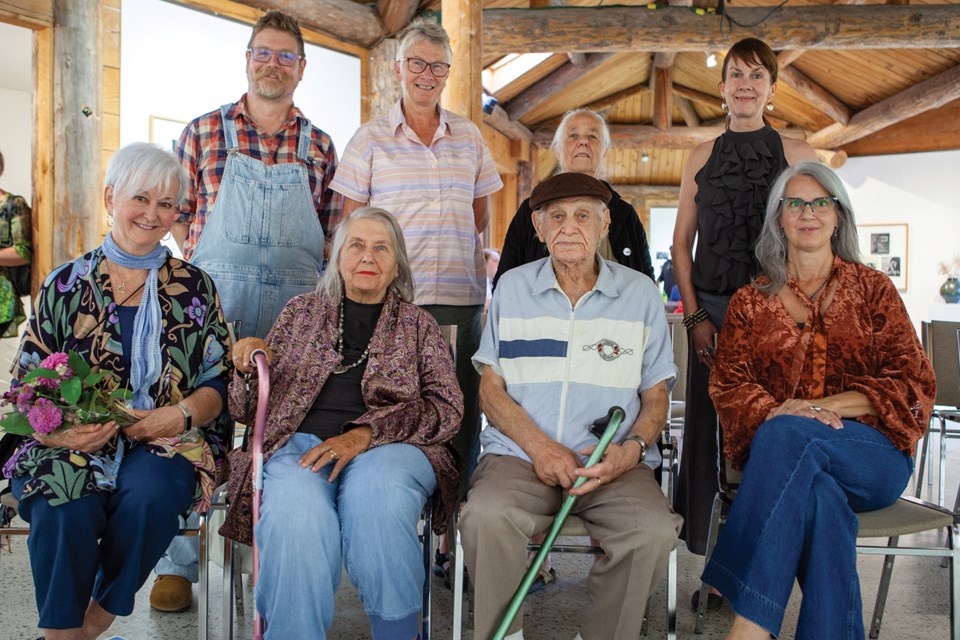Awards presented by the Sunshine Coast Arts Council on Sept. 9 recognized cultural luminaries who have shaped the region’s artistic landscape and emphasized that creativity can flourish at every stage of life.
A crowd of nearly 50 gathered at the council’s Sechelt headquarters for the awards reception, which was held in-person for the first time since the onset of the COVID-19 pandemic.
“What continues to astound me about the Sunshine Coast is both its artistic organizations and also the depth of diversity of its creative people,” said Brett Jasch, chair of the six-member awards committee. Jasch also officiated over the afternoon ceremony.
Betty Ackroyd, a potter who specializes in hand-shaped ceramics, received the Anne and Philip Klein Visual Arts Award. The distinction recognizes artists who begin a discipline later in life.
After her retirement, Ackroyd was introduced to pottery by an 81-year-old woman whom she befriended in an exercise class. “She encouraged me to continue on with the clay,” Ackroyd recalled. “I hope that this award might encourage people to pursue their artistic dreams no matter how old they are.”
Michael Klein instituted the award together with his siblings in 2000 to honour their parents. Klein described how Anne and Philip Klein embraced new metiers after retirement. Anne became a weaver. Philip — previously an animator for Disney films — began sculpting in metal.
Patricia and Murray Drope received the Frances Wasserlein Award for their leadership in supporting the Gibsons Public Art Gallery. The pair have been involved since the institution’s inception. Murray negotiated the lease for the gallery’s first location in the Quay Building, and a decade later he managed its move to the present site. Patricia served as the first president of its board of directors and ultimately served three terms in the role.
“These two really got GPAG to where it is today,” said Sue Inglis. Inglis is part of a book club that in 2017 created the award to commemorate former member Frances Wasserlein, an advocate for women and LGBTQ2+ rights. “When you think about it, all the people who know who work in organizations as volunteers, you don’t often see a couple working side-by-side, decade after decade,” Inglis observed.
“We intend to share this award,” said Murray Drope, “with Christina [Symons, manager of the Gibsons Public Art Gallery] and all the good people of GPAG.”
It was Christina Symons herself, as a member of the awards committee, who presented the next honour. The Gillian Lowndes Memorial Award (named for a talented young dancer who died in 1981) recognized visual artist Nadina Tandy.
“Nadina’s playful point of view, honouring diversity, creativity and weirdness in everyday life, is celebrated by all who know and love her,” said Symons.
Tandy’s recent exhibitions have focused on large-scale autobiographical collage, with creations featured locally and in shows across the continent. During the ceremony she announced that she will soon be exploring the use of animation in her artworks.
The final award — the Louise Baril Memorial Music Award, named for the director of a precursor to today’s Coast Recital Society — went to musician Cassidy Wieler. Presenter Sandi McGinnis described Wieler’s skill on violin and cello. Wieler, who now studies music at Western University and music production at Fanshawe College, has played with numerous local ensembles including the Coast String Fiddlers. She received four prizes during April’s Sunshine Coast Festival of the Performing Arts, including the Senior Folk Award.
Wieler’s mother, Gaylin Webber, accepted the award on her daughter’s behalf. “Cassidy commented on how the community is so incredibly supportive,” Webber said. “That’s what made her successful, she believes, being in such a supportive community.”
This year the arts council modified its selection process by proactively requesting award candidates from regional organizations. “We found that with this newer process of us going out into the different communities, we got to hear about people that wouldn’t necessarily have participated in a nomination-based structure,” said Jasch. “I think it gives us a more holistic appreciation for the arts community and the people within it.”






